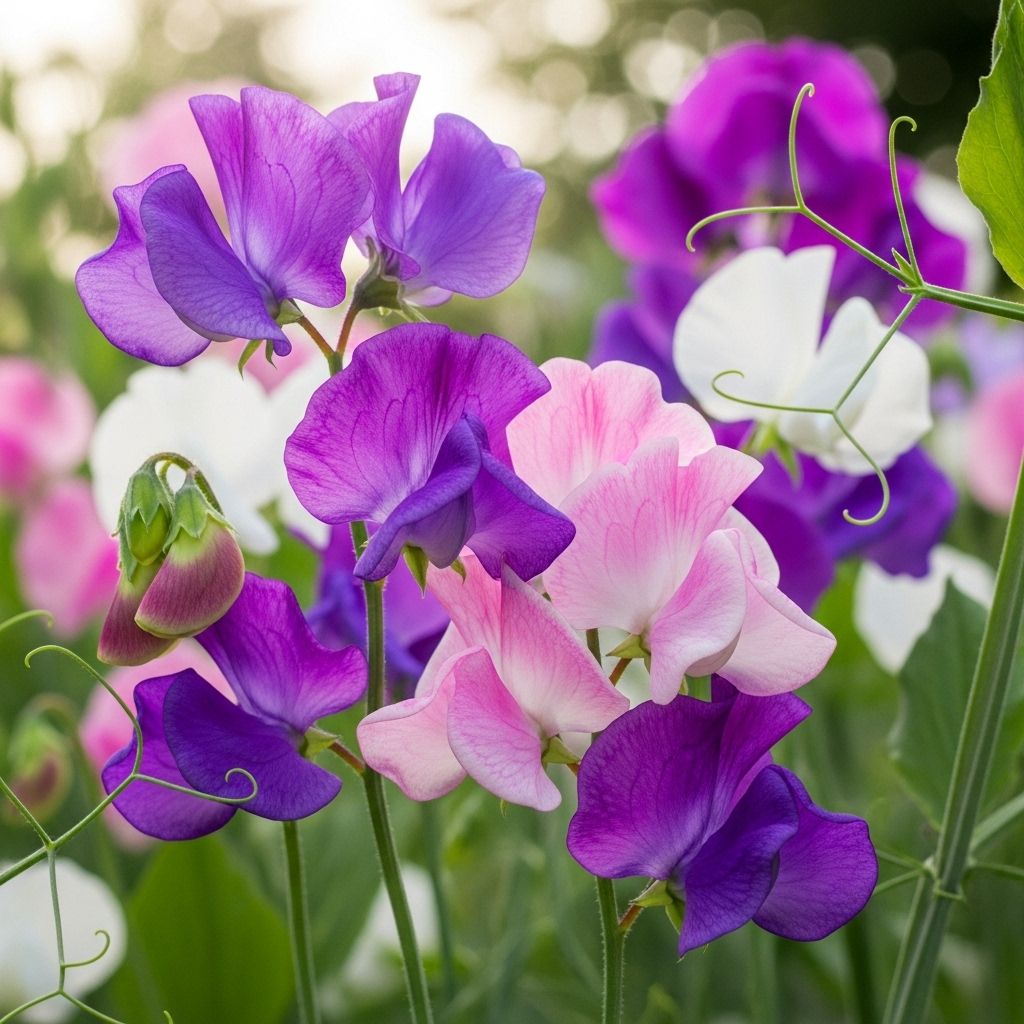How To Grow Sweet Peas: Complete Guide For Fragrant Blooms
Discover the charm of sweet peas, from sowing and care to the most fragrant and beautiful varieties for your garden.

Image: HearthJunction Design Team
Sweet Pea Flowers: A Complete Grower’s Guide
Sweet peas (Lathyrus odoratus) are treasured for their intoxicating fragrance, exquisite blooms, and captivating colors. These charming annuals capture gardeners’ hearts year after year, making them a classic staple in flower beds, cutting gardens, and cottage landscapes. This comprehensive guide covers everything you need to know about sweet peas—including how to grow them, favorite varieties, and expert tips for success.
Why Grow Sweet Peas?
- Fragrant Blooms: Sweet peas are renowned for their wonderfully perfumed flowers, with many varieties offering a strong, sweet scent reminiscent of orange blossoms, jasmine, and honey.
- Variety of Colors: They come in an array of hues, spanning soft pastels to deep, dramatic shades.
- Excellent for Cutting: Their long stems and ruffled flowers make sweet peas ideal for bouquets and floral arrangements.
- Pollinator Friendly: Sweet peas attract bees and other pollinators, promoting a healthy garden ecosystem.
Getting to Know Sweet Peas
Originating in Sicily, sweet peas once grew as wild climbers with short stems and an intense orange-jasmine scent. Though modern hybrids flaunt larger, more varied flowers, some have sacrificed scent for size. It’s possible to find cultivars that combine both fragrance and beauty, offering gardeners the best of both worlds.
Types of Sweet Pea Flowers
- Annual Sweet Peas (Lathyrus odoratus): The classic, highly fragrant type grown for cutting and display. They bloom in a rainbow of colors.
- Perennial Sweet Peas (Everlasting Pea, Lathyrus latifolius): These unscented climbers are robust and flower each year with minimal maintenance, ideal for arches or wild gardens.
Top Sweet Pea Varieties
There’s a sweet pea for every gardener, whether you prize exceptional scent, bold colors, or a reliable performance for the vase. Here are some favorites:
- ‘Cupani’: A bicolored, antique variety with maroon upper petals and violet wings. Renowned for its fragrance and ease of growth.
- ‘America’: An heirloom from 1896, sporting wavy, red-and-white striped petals with a strong scent.
- ‘Old Spice’ Collection: Heirlooms blooming in shades of white, cream, pink, lavender, and purple—selected for heat-tolerance and delicious scent.
- ‘April in Paris’: A modern variety with large, creamy-yellow blossoms shaded lilac, prized for its outstanding fragrance.
- ‘Indigo King’: Deep, dramatic purple flowers with incredible scent and abundant blooms, even in heat.
- ‘Piggy Sue’: Vintage blush-pink edges on parchment-white ground. A favorite for its exquisite color and timeless appeal.
- ‘Nimbus’: Intricate, inky purple-grey streaked blooms with long stems and superb vase life.
- ‘Charlie’s Angel’: Large, soft powder-blue flowers, highly favored for cutting and fragrance.
How to Grow Sweet Peas
Sweet peas are remarkably easy to grow with proper preparation and care. Follow these steps to ensure a vibrant display:
When and Where to Plant
- Climate Considerations: In USDA Hardiness Zone 7 or colder, sow seeds in very late winter or early spring as soon as the soil can be worked. In milder climates, fall sowing is possible for earlier blooms.
- Sun Exposure: Plant sweet peas in full sun (at least 6 hours per day) for best flowering. In hotter climates, afternoon shade helps extend bloom time.
- Soil: Sweet peas thrive in rich, well-draining soil with a neutral to slightly alkaline pH. Prepare beds with compost or well-rotted manure for a nutrient boost.
Starting Sweet Peas from Seed
Sweet peas germinate best in cool soil. Here’s how to get them off to a strong start:
- Soak Seeds: For faster sprouting, soak seeds for 12–24 hours before planting. Some growers recommend nicking the seed coat with a nail file to aid water absorption. However, this is optional due to improved seed genetics in recent years.
- Sowing Indoors: In cold climates, start seeds indoors 6–8 weeks before the last expected frost. Use deep pots or root trainers to accommodate the long taproots.
- Sowing Outdoors: In mild regions, sow directly into prepared soil in late fall or early spring. Plant seeds 1 inch deep and 2–3 inches apart.
- Temperature: Ideal germination occurs at 50–55°F (10–13°C). Plants grow well between 35–50°F (1–10°C).
Transplanting and Supporting Seedlings
- Transplant Timing: Move seedlings outdoors when they have at least two sets of true leaves and soil is workable.
- Spacing: Space plants 6 inches apart to promote airflow and minimize disease.
- Support: Sweet peas are natural climbers and need trellises, fences, or netting. Install supports at planting time to avoid damaging roots later.
Sweet Pea Care Throughout the Season
Giving your sweet peas the right care ensures a long, colorful, and fragrant display throughout the season.
Watering
- Keep soil evenly moist, especially during dry spells. Avoid letting the soil dry out or become waterlogged.
Feeding
- Fertilize with a balanced or high-potash fertilizer once seedlings are established and beginning to climb. Avoid excessive nitrogen, which promotes leaves over flowers.
Pinching and Deadheading
- Pinch out the tips of seedlings when they reach 4–6 inches tall to encourage branching and bushier growth.
- Regularly remove faded blossoms (deadheading) to promote continuous blooming.
- Harvest flowers frequently for bouquets, as picking encourages more blooms.
Pests and Problems
- Aphids: Can be controlled by blasting with water or using insecticidal soap.
- Powdery Mildew: Promote air circulation and avoid overhead watering to help prevent disease.
- Slugs and Snails: Especially a risk for seedlings. Use organic slug bait or barriers if necessary.
Designing with Sweet Peas
Sweet peas are versatile in the garden and can elevate any landscape scheme:
- Cottage Gardens: Allow sweet peas to scramble over obelisks or rustic trellises for classic charm.
- Containers and Raised Beds: Choose dwarf varieties for small spaces or plant taller types in large pots with bamboo teepees.
- Mixed Borders: Combine sweet peas with roses, foxgloves, and other old-fashioned favorites for continuous color and texture.
- Cutting Gardens: Plant rows of sweet peas for sumptuous, scented bouquets throughout the flowering season.
When—and How Long—Do Sweet Peas Bloom?
- Blooming time depends on sowing date and weather. Fall-sown plants can flower as early as late spring; spring-sown plants follow shortly after.
- With regular picking and proper care, sweet peas bloom for 8–10 weeks, sometimes longer in cool climates.
Special Tips for Sweet Pea Success
- Rotate Planting Area: Avoid planting sweet peas in the same spot each year to minimize soil-borne pests and diseases.
- Root Depth: Sweet peas have long taproots. Use deep containers if growing in pots, and prepare garden beds to a depth of 12 inches or more.
- Mulching: Apply organic mulch to help retain moisture and suppress weeds.
Growing Perennial Sweet Peas
Perennial varieties (Lathyrus latifolius) are easy to grow and return year after year. While lacking the signature scent of annual sweet peas, they offer abundant blooms and make excellent low-maintenance climbers for fences, trellises, or wildflower gardens. They are hardy to Zone 5 and reach heights of 6–7 feet.
Table: Sweet Pea Varieties at a Glance
| Variety | Color | Fragrance | Type | Notes |
|---|---|---|---|---|
| ‘Cupani’ | Maroon & violet | Very high | Annual | Bicolor, antique, easy to grow |
| ‘America’ | Red & white stripes | Strong | Annual | Heirloom, wavy petals |
| ‘April in Paris’ | Cream & lilac | Outstanding | Annual | Modern, large flowers |
| ‘Indigo King’ | Deep purple | Excellent | Annual | Abundant, heat-tolerant |
| ‘Piggy Sue’ | Blush pink on parchment | Good | Annual | Vintage tones |
| ‘Nimbus’ | Purple-grey streaked | Good | Annual | Streaked, long vase life |
| ‘Old Spice’ Collection | Mixed | Excellent | Annual | Heat resistant, heirloom mix |
| Perennial Sweet Pea | Pink, white, red | None | Perennial | Long blooming, hardy |
Frequently Asked Questions (FAQs)
How do I get sweet peas to flower longer?
Pick flowers regularly—ideally every day or two. Remove faded blooms promptly and keep the plants well watered. Provide afternoon shade in hot climates.
Do sweet peas need support?
Yes, most sweet peas are climbers and require trellises, stakes, or netting to grow upright and produce long stems suitable for cutting.
Are sweet pea flowers edible?
No, sweet pea flowers and seeds are toxic if ingested and should not be eaten. Take care to differentiate them from edible peas in the garden.
Can I grow sweet peas in containers?
Yes! Choose compact or dwarf cultivars, and use deep pots with good drainage. Provide support, such as bamboo teepees, even in containers.
How do perennial sweet peas differ from annuals?
Perennial sweet peas (Lathyrus latifolius) return every year and are unscented, while annual sweet peas (Lathyrus odoratus) must be sown each year and are prized for their fragrance.
Conclusion
Sweet peas are among the easiest and most rewarding flowers to grow, filling your garden with color and fragrance and providing plenty of blooms for bouquets. Whether you love antique charmers or bold, modern varieties, sweet peas are sure to steal the show from spring to early summer. With the right care, you’ll enjoy their enchanting presence year after year.
References
- https://www.floretflowers.com/resources/how-to-grow-sweet-peas/
- https://twosistersflowerfarm.com/how-to-grow-sweet-peas-from-seed/
- https://www.gracealexanderflowers.co.uk/writing/how-to-grow-sweet-pea-flowers
- https://sweetpeagardens.com/blogs/news/sweet-pea-grow-along-guide-weekly-steps-to-start-and-grow
- https://www.almanac.com/plant/sweet-peas
Read full bio of Srija Burman












